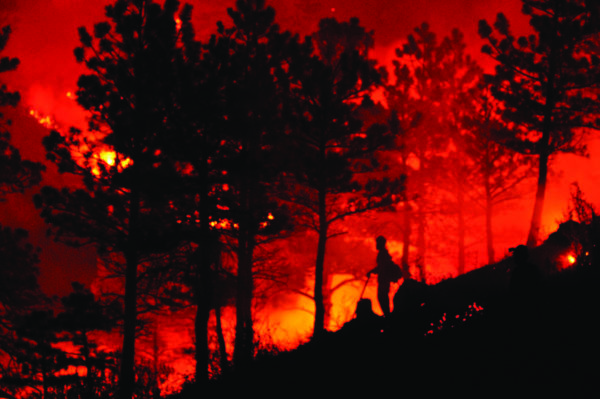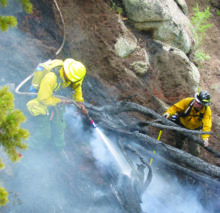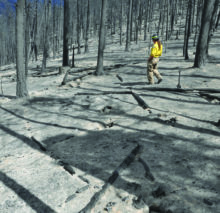Wildfire: On the Front Lines with Station 8: A book excerpt

Photographs by Dave Zader
When news of the Camp Fire in northern California began to emerge early last November my thoughts snagged on certain phrases — “wind-driven, fast-moving, heavily populated.” I’d been studying and reporting on wildfire since 2015 and knew those factors plus hot and dry conditions made it likely that lives had already been lost and homes wrecked in the foothills of the Sierra Nevada mountains. As the ash settled, the totals were grim — at least 88 dead (dozens more were still missing at the time of this writing, three weeks later) — and nearly 19,000 structures and 150,000 acres had burned. Tens of thousands of residents who’d managed to escape the blaze slept uneasily in shelters, either having no home to return to or waiting out what is often wildfire’s second act — heavy rain that brings ash, mud and debris flows through the burn area.
The Camp Fire was the deadliest wildfire in California on record in more than a century. I learned in my reporting for my latest book, “Wildfire: On the Front Lines with Station 8,” that it’s part of a new abnormal that is characterized by bigger, deadlier, costlier and more destructive blazes. Wildfire is a natural part of many ecosystems, and we cannot and should not prevent it from performing its duty on the landscape — thinning forests, clearing underbrush, killing pests and prompting new growth. But for a century we have sought to control fire, tamping it down at every opportunity, and that has left us with overgrown forests in many places, particularly the West. It’s tempting to blame forest management alone, but that ignores the critical part we all play in the current crisis. Without fire on the landscape we were further emboldened to build millions of homes in or near the wild.
Too many trees or too many people among them is, however, only part of the problem. It is climate change that is really driving the extreme fire behavior we’ve seen in recent years. Studies estimate that from 1984 to 2015 the area burned was twice what it would have been without climate change. Nationally, temperatures are going up and humidity levels are going down, which means spring is coming earlier and vegetation has more time to dry out. This has lengthened the traditional fire season and has made conflagrations more severe. Most firefighters and scientists I talked to agree on how to solve the problem — knowing it won’t be easy — but the personal and political will to get it done is static. In the meantime, we should expect many more heartbreaking, life-altering wildfires.
While reporting for this book, I became a certified wildland firefighter, and spent roughly 18 (exhausting) months embedded with an elite wildland fire crew in my hometown, Boulder, Colorado. I’ve been close to fire’s chaos — skin prickling from the heat and throat closing around the smoke. What you’ll read on the following pages is an excerpt from the book, my account of a growing wildfire near my city, which is part of a bigger story about firefighters getting an increasing number of dangerous calls to battle blazes in bone-dry terrain.
—By Heather Hansen ’94
Ignition
DAY ONE (SATURDAY)

July 9, 2016, dawned warm and quiet in Nederland, a small mountaintown at the top of Boulder Canyon. Mike Smith had on his off-duty summer uniform — shorts, T-shirt, flip-flops and visor. Fly-fishing gear in hand, he headed out the door around 6:30 a.m. Just ten minutes from home, Smith met an old friend at Arapaho Ranch, and there they waded into the transparent creek to cast their lines. The sky was cobalt and clear except for a few storybook puffy clouds. That “glorious morning,” as Smith described it, couldn’t have been more different from what lay ahead.
It was the beginning of a much-needed weekend off. He had just spent two weeks as a supervisor in New Mexico on the Dog Head Fire in the Cibola National Forest. The fast-moving blaze in the Manzano Mountains east of Albuquerque engulfed burly stands of ponderosa pine and tangles of juniper, helped along by a string of 95-degree days and relative humidity hovering around 10 percent. The fire started small, as they all do, but Dog Head soon grew from puppy to beast. On day three, after sundown when fires generally hush, the flames blasted forward and sideways more than 10 miles. NASA’s Terra satellite captured an image of the voluminous smoke as it blanketed states to the north and east.
In the middle of New Mexico, several hundred firefighters cut fire lines and did what they could on the ground to fortify hundreds of homes. From above, six air tankers dropped dozens of loads of flame retardant, and a handful of helicopters did countless water drops in an effort to slow the fire’s advance. The National Guard assisted with evacuations; an archbishop in Santa Fe offered a prayer for first responders (and for rain); and inmates at a state prison donated hygiene kits to displaced homeowners made from items bought at their commissary. Ironically, the fire was started by a masticator, a tool used in forest thinning, which was being used on a wildfire mitigation project. Some fuels being chewed up by the machine ignited, and the crew on site could not quickly quash it. Ultimately, the blaze cut across 18,000 acres, terrorized several small communities and burned a dozen homes.
Smith had just returned from that event, and he and his teammates at Station 8 had also just made it through the Fourth of July — one of those hold-your-breath-till-it’s-over holidays during wildfire season — without serious incident in Boulder. On that Saturday, the perfect antidote to the weeks past was a cold stream and a cool beverage. Smith spent the morning casting his fly and reeling in a few comically small rainbow trout and a lot of brookies. But the beers would have to wait.
The sun climbed high and dragged the temperature along with it. Residents and visitors went about their errands, barbecues, hiking, cycling, paddling, yard work. Then, around 1:30 p.m., tentative puffs of smoke gathered near the junction of Cold Springs Drive and Peak to Peak Scenic Byway, Colorado’s oldest scenic route, which is flanked with groves of conifer and aspen and views of burly peaks. Unpaved roads off the highway lead to trailheads, alpine lakes, campgrounds and ghost towns.
Cold Springs Drive is a dirt road bordered by a low wood-slat fence. Beyond the fence lies private land covered with tall grass, some aspen and pine. A little farther east the road crosses North Boulder Creek, and the land gets lumpy with tree-clogged gullies, rocky knolls and pine-covered hills. The immediate road is sparsely populated, but, for miles in every compass direction, there are housing subdivisions. About 2 miles southwest lay downtown Nederland, where the ice cream cone–licking kids and espresso-sipping adults were also about to have a change of plans.
When the initial smoke report came over the radio, Smith couldn’t see it from where he was. He sent a local engine to check it out while he drove into Nederland to get eyes on the fire. From there Smith wasn’t worried about the look of it; it was disorganized, and it seemed as if a big bucket of water might let everyone get back to their weekend. But within minutes the smoke began to pull itself together and billow skyward in consistent puffs.
“I sent the engine thinking it was going to be nothing, then a bunch of 911s were coming in. So I hauled ass home and grabbed my work truck and wildland jammies,” Smith said (“jammies” being wildfire garb, including fire-resistant Nomex shirt and pants, and shin-high leather boots).
Fire has just three requirements, two of which (fuel and oxygen) are almost always present. The third is heat, which comes first as an ignition source. All it takes is lightning, enough friction, the spark of metal on metal, a discarded cigarette or an ember from a longforgotten campfire to turn things upside down.
Within fifteen minutes of the initial smoke report, Smith arrived at a vantage point west of the fire. He could see it had burned just an acre or so, and he was relieved it still looked manageable. “When I first got there I thought, ‘This isn’t going to be that big of a deal. We’ll catch this at a couple of acres, and it’ll be fine.'” His old boss, Nederland’s Fire Chief Rick Dirr, greeted him. Since Smith is qualified to command national incidents up to a Type 3 severity, Dirr immediately put Smith in charge of the fire as the initial attack incident commander. The first engine Smith sent to the fire came from Station 1 of Nederland Fire, which like most fire departments in these hills is a mostly volunteer corps of emergency responders. But Charlie Schmidtmann, an experienced firefighter and the Nederland Fire Captain, was also among them. There was no vehicle access to the fire since it was burning in remote terrain, so a handful of firefighters toted bladder bags, or water packs with pumps, on their backs up the steep hill to the point of origin. It wasn’t long before they were forced to retreat.
 Just nine minutes from the time Smith assumed command of what he named the “Cold Springs Fire,” he was taken aback by a bold move. “The fire stood up,” he reported later, and made a 40-acre or so run up a hill and across a ridge. He thought, “Alright, we’re not going to catch this.” The fire growth and unpredictability had him worried about life safety, and he pulled back the Station 1 engine crew until he could reassess the situation. At the same time he began to call in the cavalry.
Just nine minutes from the time Smith assumed command of what he named the “Cold Springs Fire,” he was taken aback by a bold move. “The fire stood up,” he reported later, and made a 40-acre or so run up a hill and across a ridge. He thought, “Alright, we’re not going to catch this.” The fire growth and unpredictability had him worried about life safety, and he pulled back the Station 1 engine crew until he could reassess the situation. At the same time he began to call in the cavalry.
“Very intentionally right before I ‘cued the mike,’ I took a big breath,” he said. “I wanted everyone on the radio to hear me as ‘smooth jazz voice.'” Smith had lived and worked in this area for many years. He knew these woods and subdivisions better than most and had started playing out various scenarios in his mind for how the fire in front of him could progress. He didn’t like what he saw — a lot of people, many homes and a blaze that was acting erratically. But it was important to him to set a “calm operational tempo” in his radio appeal. “Everybody knew it was blowing up by the amount of resources I was ordering but not by how I was acting,” he said. The dispatcher he was ordering resources from at first sounded incredulous about the request — aircraft, engines and highly experienced crews. “I just kept saying, ‘Yeah, here’s what I need.'” Those resources would prove critical in the coming days.
That morning before the fire started, Jamie Carpenter had checked off an item long on his “bucket list” — cycling from Rollinsville to Winter Park. The 25-mile route climbs more than 3,500 feet, over the Continental Divide at 12,000 feet, before dropping down to Winter Park. Carpenter was looking forward to lunch and a cocktail, when he got a cryptic phone call from a colleague about smoke in Nederland. He checked with the Boulder County Office of Emergency Management and, at least initially, wasn’t too concerned. “But then I looked up and saw the [smoke] column and I thought, ‘Oh, boy.'” He called [team member Mike “Smitty”] Smith.
Smith barked into the phone, “I’m getting my ass kicked! Where are you? Get down here!”
Carpenter told Smith he was on his way. Then he rang [Matt] Hise at Station 8. Hise had just picked up his young son from the airport for a two-week visit. So he had to drop him off to stay with family.
As the minutes ticked by, the news on the fire wasn’t getting any better. “[Hise] tells me the fire is at Peak to Peak and Cold Springs and it’s making a run east,” said Carpenter. It was heading directly toward many homes, including his own. Carpenter and his wife, Annie, didn’t know if they’d be able to get to their house but they decided to try. They piled into the car with their border collie, Whalen, and headed east, back over the Divide.
After a wet spring, the grasses and shrubs had come up tall and dense on Colorado’s Front Range. They grew atop thick mats of dead vegetation from seasons past, a cycle of spring blooms and winter die-offs that was several years in the making. The beginning of July was characteristically hot and dry, though warmer and with less rain than normal. One fire meteorologist reported that Boulder County, compared to areas north and south along the Front Range, was an especially dry geographic pocket with only 40 to 60 percent of average moisture. Across thousands of acres of private land and open space in Boulder County, the foothills’ once green carpet had cured into a yellow-brown thatch, a veritable welcome mat for fire. Trees and shrubs were also stressed; some needles were turning rust-colored in protest of the lack of moisture. Some state and federal entities pre-positioned a handful of fire response resources along the Front Range. The dry, hot, windy days came together to form a trifecta of fire fears.
The crew at Station 8 was on guard; they knew a fire under those conditions would be formidable. Weeks of mental training in the cooler months had helped them shake off the rust built up over several quiet seasons.
And they pushed themselves on ass-busting workouts day after day. They played out fire scenarios in different locations around the county. But when I had asked at the end of that winter, “Are you ready?” there was an air of caution in their responses. Hearing the tones for a wildland fire over the radio is like having a starting gun go off in the room. No one really knows for sure if their legs will carry them, if their minds will guide them. We were all about to find out.

I had spent the weekend in Fort Collins, about an hour’s drive north of Boulder, feeling uneasy. [The division’s wildland fire operations manager Brian] Oliver was my main conduit to Station 8, and I knew he would call me if there was any fire activity in or around Boulder.
But he’d gone to Idaho on a fire assignment. Plus, it was a Saturday after a long week on high alert and most of the crew was trying to relax. So I settled for listening to the police scanner online and refreshing a local news website on my phone every hour or so. I was watching the weather incessantly, like the Station 8 crew. I had a nagging feeling, and in the early afternoon I took a screen shot on my phone of the weather in Boulder—91 degrees, 13 percent humidity, 6-mile-per-hour northeast wind. It was the perfect beach day, and ideal for a fire.
At 2:15 p.m. Smith did his first official “size-up” of the incident. He reported: “Cold Springs Fire; 60 acres; running and torching; short crown runs; spreads 20 to 40 chains per hour, spread potential high; spreading to the east; ownership is county; numerous structures threatened, some likely lost; cause is human, campfire identified.” The report was a dire one. A “running” fire is rapidly spreading with a well-defined head, or intense forward momentum. “Torching” meant Smith was seeing a surface fire move into the crowns of trees, then drop down again to the ground. “Crown runs” meant the fire was advancing across the tops of trees mostly independently of the surface fire — very serious fire behavior. The fact the fire was moving at 20 to 40 chains per hour was another indication of intense conditions. “Chains per hour” are units used to describe the fire’s rate of spread (ROS). One chain (a surveying term) equals 66 feet. Smith could estimate the ROS by watching how fast the blaze was spreading in 1 minute; 1 foot in 1 minute meant 1 chain per hour, and 20 to 40 chains per hour meant the fire was moving upward of a half-mile per hour.
Smith knew that putting firefighters anywhere on the head, flanks or rear of the fire were not options at that moment. The fire was acting too erratically to order anyone to go “direct” on it. With a complex mix of fuels, topography and weather in the area, the fire could sprout new heads or fingers in any direction. It could also back up onto itself, making the “black,” or already burned area that is usually the safest place for firefighters, a dangerous one. If an area has not burned thoroughly, it can easily burn again with a shift of the wind. So Smith set up a defensive line of firefighters along Ridge Road, which runs parallel to Cold Springs to the south, in hopes of stopping the blaze there. If the fire reached them, they would do their best to hold their ground and tamp it down, but they would not go chasing it through the woods. “My directive is nobody engages this fire. We’re doing point protection and evacuations; we need to get people out of the way and keep firefighters in safe locations. We’ll catch this thing when we can catch it,” he said.
Within an hour of the ignition Smith had ordered additional major resources — multiple engines, helicopters, heavy air-tankers and an air attack. His rationale was this: The engine crews could start making efforts to protect structures. The helicopters could dip their buckets in the nearby Barker Reservoir and douse the flames. The heavy air-tankers could drop retardant in targeted strips to try to slow the advance of the fire. And the air attack could be the ground crews’ eyes in the sky. Smith was feeling good about the crews requested, until dispatch came back to him with some bad news — the three hotshot crews and three Type 2 crews he ordered were not available locally. They had all been sent to other fires. Smith told dispatch, “Let’s go national; I don’t care where they come from, ’cause we’re going to need them for the long haul. Order them.”
Excerpted with permission from “Wildfire: On the Front Lines with Station 8” (Mountaineers Books, March 2018) by Heather Hansen.
This article appeared as “Wild Fire” in the winter 2019 issue of the Alumnae Quarterly.
February 22, 2019










Leave a Reply